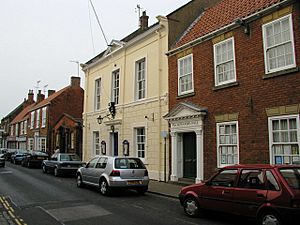Henry Guy (politician) facts for kids
Henry Guy (born June 16, 1631 – died February 23, 1710) was an important English politician. He lived during the time of kings Charles II and James II. Guy was known for his work in the government's money department.
Henry Guy's Early Life
Henry Guy was born on June 16, 1631, in Great Berkhampstead. His father was also named Henry Guy. His mother, Elizabeth, lived to be 90 years old. She was buried in Tring Church.
Henry first studied law at the Inner Temple in London. However, he decided to pursue a career in politics instead. He also spent some time at Christ Church, Oxford University. In 1663, he earned a Master of Arts degree. Later, he worked collecting taxes in northern England. He became well-liked in the town of Hedon in Yorkshire. He was made a free citizen of Hedon in 1669.
Henry Guy's Political Career
In 1670, Henry Guy was elected as a Member of Parliament (MP) for Hedon. He represented this town in Parliament for many years until 1695. He was again an MP for Hedon from 1702 to 1705. During his time as an MP, he paid for the building of Hedon Town Hall. He gave it to the local council in 1693. In Parliament, Guy often spoke for the Earl of Sunderland's political group.
Henry Guy's first job at the royal court was as a cupbearer to the queen. Soon, he became a close friend of King Charles II. In 1675, he became a Groom of the Bedchamber. This was an important role in the king's personal staff.
In 1679, Guy was appointed Secretary to the Treasury. This meant he was in charge of managing the government's money. He handled payments from public funds until 1688. He kept detailed records of money used for secret services by King Charles II and King James II. These records show how much money he managed for the kings.
Henry Guy's Estates and Later Years
After Queen Henrietta Maria died in 1669, Henry Guy received the Tring estate. He built a large house and beautiful gardens there. The famous architect Sir Christopher Wren designed the property. Guy later sold this estate in 1702.
In 1680, he also gained control of land in Hemel Hempstead for thirty years. In 1686, he was given some lands in Ireland by the king. He also inherited a lot of money from a wealthy man named Thomas Naylor. King William III even visited Guy at his home in Tring in 1690.
In 1691, Guy became a commissioner of customs. This job involved managing taxes on goods coming into the country. However, he returned to his role as Secretary of the Treasury in June of that year. In 1695, he faced a serious accusation about his work. Because of this, he had to resign from his job. He was held in the Tower of London for a short time. In 1696, he helped guarantee a large loan from the Dutch government.
Henry Guy passed away on February 23, 1710, at the age of 78. He left a significant amount of money and income to William Pulteney. Pulteney later became the MP for Hedon, just like Guy.


